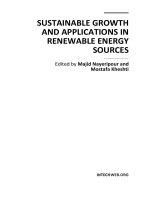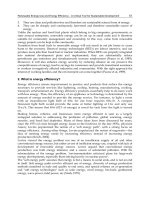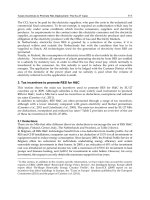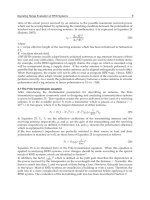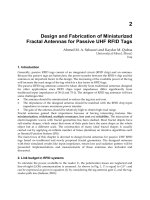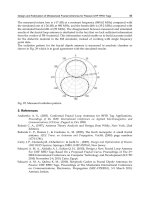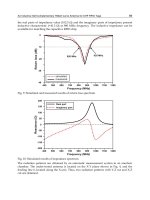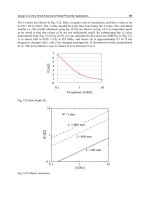Radio Frequency Identification Fundamentals and Applications, Bringing Research to Practice Part 1 potx
Bạn đang xem bản rút gọn của tài liệu. Xem và tải ngay bản đầy đủ của tài liệu tại đây (2.15 MB, 20 trang )
Radio Frequency Identification
Fundamentals and Applications,
Bringing Research to Practice
Radio Frequency Identification
Fundamentals and Applications,
Bringing Research to Practice
Edited by
Cristina Turcu
Intech
IV
Published by Intech
Intech
Olajnica 19/2, 32000 Vukovar, Croatia
Abstracting and non-profit use of the material is permitted with credit to the source. Statements and
opinions expressed in the chapters are these of the individual contributors and not necessarily those of
the editors or publisher. No responsibility is accepted for the accuracy of information contained in the
published articles. Publisher assumes no responsibility liability for any damage or injury to persons or
property arising out of the use of any materials, instructions, methods or ideas contained inside. After
this work has been published by the Intech, authors have the right to republish it, in whole or part, in
any publication of which they are an author or editor, and the make other personal use of the work.
© 2010 Intech
Free online edition of this book you can find under www.sciyo.com
Additional copies can be obtained from:
First published February 2010
Printed in India
Technical Editor: Teodora Smiljanic
Cover designed by Dino Smrekar
Radio Frequency Identification Fundamentals and Applications, Bringing Research to Practice,
Edited by Cristina Turcu
p. cm.
ISBN 978-953-7619-73-2
Preface
This book, entitled Radio Frequency Identification Fundamentals and Applications, Bringing
Research to Practice, bridges the gap between theory and practice and brings together a
variety of research results and practical solutions in the field of RFID. The book is a rich
collection of articles written by people from all over the world: teachers, researchers,
engineers, and technical people with strong background in the RFID area. Developed as a
source of information on RFID technology, the book addresses a wide audience including
designers for RFID systems, researchers, students and any person who would like to learn
about this field.
The first chapter of this book analyzes an algorithm for interrogation zone estimation in
inductive coupled anti-collision RFID identification systems. The field aspects of operation
conditions are taken into consideration.
Chapter 2 presents an overview of the RFID identification process and focuses on how
RFID systems work in static and dynamic scenarios, collisions in the Medium Access
Control (MAC) layer, the more relevant and adopted EPCglobal specifications and the
performance analysis of the identification process.
In chapter 3 the author reviews several approaches in solving passive RFID tag collision
problems.
Chapter 4 addresses two important issues related to RFID system: electronic and MAC
protocol characterization to avoid reader-reader and reader-tag collisions in a dense RFID
network.
Chapter 5 aims to analyze the MAC technologies adopted in RFID, considering both
deterministic and stochastic MAC protocols for RFID systems proposed in standards,
specifications and recent literature. Their principles are described and their performance is
assessed and compared through theoretical and numerical arguments.
Chapter 6 is dedicated to stochastic model and performance analysis of RFID. The
chapter comprises reviews of the frame slotted ALOHA based tag anti-collision protocols.
Also, the authors investigated a stochastic model for RFID tag collision resolution. Various
methods proposed for the estimation of RFID tag population within the vicinity of the RFID
reader are examined and evaluated.
Chapter 7 presents an overview of several RFID anti-collision algorithms and proposes
an improved dynamic framed slotted ALOHA algorithm for a large number of tags.
VI
Chapter 8 briefly reviews already existing RFID systems and provides an in-depth
analysis of a commercial development system. The authors present a speed measurement
application using the same RFID system and important EMC information regarding the use
of high frequency RFID system.
In chapter 9 the authors propose an IP-based RFID architecture that allows low cost and
large scale deployment, as well as an easy integration with IP-based services.
Chapter 10 presents the fundamentals of object tracking and focuses on one special
technique to develop an RFID network and the ways in which tagged objects can be tracked
in such a network.
Chapter 11 deals with the designing and verifying the secure authentication protocol,
which is widely researched in RFID systems using formal methods. Thus, the RFID security
requirements in home network environments are defined, and an authentication mechanism
among reader, tag and database is proposed.
The authors of chapter 12 propose an RFID tag system that includes an interrogator
with an algorithm that generates RFID passwords to protect both the RFID data and
consumer privacy.
In chapter 13 the authors describe an authentication mechanism based on the COMP-
128 algorithm to be used in mobile RFID environments.
Chapter 14 offers an introduction to RFID systems, summarizes several concepts of
RFID system integration, and introduces some integration examples of RFID applications.
Chapter 15 focuses on major short and long-term benefits of RFID systems and advices
on efficient RFID technology integration.
Chapter 16 explores fundamentals of data management in RFID applications so that the
data retrieved out of RFID applications is non-redundant and filtered.
Chapter 17 discusses different design possibilities for data storage in RFID systems and
their impact on the quality factors of the resulting system.
In the final chapter of this book the authors introduce the widely applied RFID
middlewares with the technique of Web services and propose a Context store approach to
improve the performance of data transmission between a mobile client and a Web services
server.
At this point I would like to express my thanks to all scientists who were kind enough
to contribute to the success of this project by presenting numerous technical studies and
research results. But, we couldn’t have published this book without InTech team’s effort. I
wish to extend my most sincere gratitude to the InTech publishing house for continuing to
publish new, interesting and valuable books for all of us.
Editor
Cristina TURCU
Department of Computer Science
Stefan cel Mare University of Suceava
Romania
Contents
Preface V
1. Field Conditions of Interrogation Zone in Anticollision Radio Frequency
Identification Systems with Inductive Coupling
001
Piotr Jankowski-Mihułowicz
2. Characterization of the Identification Process in RFID Systems 027
J. Vales-Alonso, M.V. Bueno-Delgado, E. Egea-López,
J.J. Alcaraz-Espín and F.J. González-Castaño
3. The Approaches in Solving Passive RFID Tag Collision Problems 049
Hsin-Chin Liu
4. Electronic and Mac Protocol Characterization of RFID Modules 057
Nasri Nejah, Kachouri Abdennaceur, Andrieux Laurent and Samet Mounir
5. MAC Protocols for RFID Systems
073
Marco Baldi and Ennio Gambi
6. Stochastical Model and Performance Analysis
of Frequency Radio Identification
087
Yan Xinqing, Yin Zhouping and Xiong Youlun
7. Anti-collision Algorithms for Multi-Tag RFID 103
GENG Shu-qin, WU Wu-chen, HOU Li-gang and ZHANG Wang
8. Applications of RFID Systems - Localization and Speed Measurement 113
Valentin Popa, Eugen Coca and Mihai Dimian
9. IP-based RFID Location System 131
Phuoc Nguyen Tran and Nadia Boukhatem
VIII
10. Tracking Methodologies in RFID Network 145
M Ayoub Khan
11. The Modeling and Analysis of the Strong Authentication Protocol
for Secure RFID System
157
Hyun-Seok Kim and Jin-Young Choi
12. Evaluation of Group Management of RFID Passwords
for Privacy Protection
171
Yuichi Kobayashi, Toshiyuki Kuwana, Yoji Taniguchi and Norihisa Komoda
13. A Mobile RFID Authentication Scheme Based
on the COMP-128 Algorithm
183
Jia-Ning Luo and Ming Hour Yang
14. RFID System Integration and Application Examples 197
Ming-Shen Jian
15. RFID System Integration 211
Hamid Jabbar and Taikyeong Ted. Jeong
16. RFID Data Management 229
Sapna Tyagi, M Ayoub Khan
and A Q Ansari
17. Data Storage in RFID Systems 251
Dirk Henrici, Aneta Kabzeva, Tino Fleuren and Paul Müller
18. An Efficient Approach for Data Transmission in RFID Middleware 267
Hongying LIU, Satoshi GOTO and Junhuai LI
1
Field Conditions of Interrogation Zone in
Anticollision Radio Frequency Identification
Systems with Inductive Coupling
Piotr Jankowski-Mihułowicz
Rzeszów University of Technology
Poland
1. Introduction
Passive Radio Frequency IDentification (RFID) systems with inductive coupling are
the most widespread nowadays (Yan et al., 2008; Wolfram et al., 2008). These systems
operate thanks to direct inductive coupling between antenna units of the communication
system which consist of Read/Write Device (RWD) and electronic identifier (called a tag
or transponder). The communication in transmitter – receiver set is carried out in two ways.
In the first case, only one object with electronic tag can be placed in the correct working area
called interrogation zone of the RFID system. This arrangement is called a single
identification system or also single system. In the second case of multiple identification
system, called anticollision system, the communication process is carried out
simultaneously with multiple RFID tags. In this process, the algorithms of multi-access to
the radio channel are used, what provides an effective way to distinguish simultaneously
between multiple objects (Yeh et al., 2009; Dobkin & Wandinger, 2005). It should be note
that synthesis procedure of interrogation zone includes the simultaneous analysis of
electromagnetic field (presented in this paper), communication protocols and electric
aspects of operation conditions in the process of system efficiency identification. The typical
applications of anticollision RFID systems are concentrated on different economic and
public activity in industry, commerce, science, medicine and others (Harrison, 2009,
Donaljdson, 2009; Steden, 2005; Wyld, 2009 and 2005; Åhlström, 2005).
When determining the interrogation zone for the given automatic identification process,
it is necessary to define a maximum working distance of the RFID system. This parameter
determines the distance between the specified point of the RWD’s and the midpoint
of the tag’s antenna loop. It is very important because the magnetic field generated around
the RWD’s antenna loop is not only medium of information signal but also provides passive
tags with energy. The proper supply is essential to carry out operations of recording and
reading information which is stored in the transponder’s semiconductor memory (Fig. 1).
The basic parameter, which determines the working area and characterizes the maximum
working distance of the RFID system, is H
min
minimum value of magnetic field strength
or more often used B
min
minimum value of magnetic induction at which the correct data
transmission between the RWD and the tag takes place (Jankowski-M. & Kalita, 2008).
The minimum value of magnetic induction required in the process of writing data to the
Radio Frequency Identification Fundamentals and Applications, Bringing Research to Practice
2
internal memory of tag (B
minWrite
) is several percent larger than the value of this parameter in
the process of reading (B
minRead
). So the operation mode of the internal memory affects
occurrence of changes in the interrogation zone. There is decreasing the maximum distance
in writing mode in comparison to reading process. During the analysis of field conditions
in RFID system the general case will be considered and represented by notation B
min
.
INTERROGATION ZONE OF ANTICOLLISION
RFID SYSTEM WITH INDUCTIVE COUPLING
(x,y,z) 3D coordinates
B magnetic induction
I
R
current of RWD antenna loop
M mutual inductance
n number of tags
CRITICAL CONSTANTS:
1) Minimal value of energy is determined by minimal value
of magnetic induction B
min
in each point of its location.
2) Maximum change of the impedance Z
R
under influence of the
tags is expressed by maximum value of difference of impedance’s
arguments Δφ
Rmax
without the tags and with them , respectively
RWD ANTENNA LOOP
RWD
Read /Write Device
(
critical constant:
Δφ
Rmax
)
I
R
M
1
M
n
B
DATA
ENERGY
RWD
ANTENNA
CIRCUIT
(x
1
,y
1
,z
1
)
(x
n
,y
n
,z
n
)
TAG n
CIRCUIT
(CHIP)
TAG n ANTENNA
LOOP
TAG n
ANTENNA
CIRCUIT
TAG 1
CIRCUIT
(CHIP)
TAG 1 ANTENNA
LOOP
TAG 1
ANTENNA
CIRCUIT
RWD antenna unit
Tag n antenna unit
(
critical constant:
B
min
)
Antenna unit array: RWD-TAGS
x
y
z
Z
R
M
2
(x
2
,y
2
,z
2
)
TAG 2
CIRCUIT
(CHIP)
TAG 2 ANTENNA
LOOP
TAG 2
ANTENNA
CIRCUIT
I
D
EN
TI
F
IC
A
T
ION
L
A
C
K
O
F
I
D
E
N
T
I
F
I
C
A
T
I
O
N
Ω
ID
INTERROGATION ZONE
OF ANTICOLLISION
RFID SYSTEM
I
D
E
N
T
I
F
I
C
A
T
I
O
N
L
A
C
K
O
F
I
D
E
N
T
I
F
I
C
A
T
I
O
N
Anticollision
RFID
System
RF identification
Simultaneous identification
of many objects
Ω
ID
Real Fast Moving
Consumer Goods
(FMCG) example
What identified ?
PROBLEM OF REALIZATION
OF ANTICOLLISION AUTOMATIC
IDENTIFICATION PROCESS
Industrial application
(pallet with products)
R
F
i
d
e
n
t
i
f
i
c
a
t
i
o
n
RF identification
Fig. 1. Block diagram of anticollision RFID system with inductive coupling and illustration
of practical automatic RFID process
Field Conditions of Interrogation Zone
in Anticollision Radio Frequency Identification Systems with Inductive Coupling
3
The B
min
value, which is considered individually for each transponder in a magnetic field of
RWD loop (Ω
ID
area – Fig. 1), depends on the structure and parameters of this loop but also
of tag antenna. In the case of multiple identification process, it is necessary to provide all
tags placed within the interrogation zone of RWD antenna with proper power. For this
geometric configuration, the parameters of magnetically coupled transponders affect
significantly the total loop impedance of RWD antenna and cause big changes in many
parameters of its electrical circuit. In consequence, this phenomenon leads to disruption in
communication with the tags which are placed within the working area but close to
boundary points where the magnetic induction has the minimal value. The correct analysis
of the total impedance in coupled system (consisted of RWD and tags antenna loops), and
thereby analysis of changes in the magnetic field in the considered interrogation zone,
allows to estimate the proper boundary of area with spatial placed multiple tags for the case
of designing anticollision RFID system with inductive coupling.
2. The operating range of RFID systems with inductive coupling
In terms of emission of electromagnetic field, the RFID systems are placed in a group of
radio equipment devices and they use allocated band in respective frequency range (Fig. 2).
Frequency f, MHz:
Wavelength λ, m:
0.1 1 10
3000 300 30
Frequency range : LF MF HF
20
40
60
80
Magnetic field strength,
H, dBµA/m
(10 m from the radiation source,
for frequency f < 30 MHz)
100-135 kHz
13,56 MHz
ETSI EN 300 330-1 V1.5.1:2006
Electromagnetic compatibility and Radio spectrum Matters (ERM);
Short Range Devices (SRD); Radio equipment in the frequency range
9 kHz to 25 MHz and inductive loop systems in the frequency range
9 kHz to 30 MHz; Part 1: Technical characteristics and test methods
R
adio
F
requency
ID
entification
systems with inductive coupling
Wave propagation RFID systems
that operates at UHF
and microwave bands:
- 865-868 MHz up to 2 W ERP
(ETSI EN 302 208, ETSI EN 300 220 ),
- 2446-2454 MHz up to 500 mW EIRP
(ETSI EN 300 440)
100 1000 10000
30.30.03
VHF UHF SHF
Fig. 2. Frequency ranges and European licensing regulation for RFID systems
Frequency bands widely available for different kind of radio systems (called ISM -
Industrial-Scientific-Medical) are used in contact-less identification of objects (ERC, 2008).
Therefore, it is required to reduce the magnetic field strength produced by a transmitting
antenna of low frequency systems, and reduce the effective radiated power for systems
operating in the range of ultra-short waves and microwaves.
Radio Frequency Identification Fundamentals and Applications, Bringing Research to Practice
4
Contact-less inductively coupled systems are used to identify objects in the range of the
lowest frequencies (in the wave ranges from medium to short). These systems are currently
the most widespread, developed and supported by all the key suppliers of RFID
components (Yan et al., 2008). They are characterized by working in the area where a strong
magnetic coupling between antennas of transmitting components occurs and also where
there is strong wave mismatching between communication equipments (Flores et al., 2005).
Assuming that the wave propagates in a vacuum, the phase coefficient β takes the real
value:
00
=
β
ωμε
(1)
where ω denotes the pulsation, μ
0
– magnetic permeability of vacuum whereas ε
0
means
electric permittivity of vacuum.
With respect to the classical theory of antennas, it is possible to specify the working distance
of inductively coupled RFID systems according to the following conditions (Fig. 3):
• for an induction zone - near field (all systems with inductive coupling):
z
<
<
λ
(2)
• for a Fresnel zone (systems operating in the range of short-wave):
1z
⋅
>
β
(3)
with signs appearing in the dependencies (2) and (3) described in Fig. 3.
13.56 MHz100 – 135 kHz
Near field (near zone ),
z << λ,
z – distance from radiation source ,
λ - wavelength (for 125 kHz – λ = 2400 m)
Fresnel zone ,
β z > 1,
β – phase constant
RFID near field functioning range approximately up to a dozen cm;
(RFID near zone) proximity range RFID systems
RFID far field functioning range up to approximately a few dozen
(RFID far zone) cm (LF) or a few meter (HF); long range RFID systems
Industry , Science, Medicine (ISM)
For memory tags in particular :
logistics
access control
work time registration
animal identification
etc.
For memory and microchip tags :
automatic charging
bank cards
parking cards
etc.
Frequency
Region defined
by the antenna theory
Example applications
Region defined
for the RFID technology
Fig. 3. Operating region of RFID systems with inductive coupling
The average distance between the transmitter and the receiver is from a few centimetres to
several meters in the case of RFID systems operating in the range of short-wave. For such a
separated working area, the value of the energy flux density transmitted by an
Field Conditions of Interrogation Zone
in Anticollision Radio Frequency Identification Systems with Inductive Coupling
5
electromagnetic wave (Poynting vector) is zero. This means that the functional principle of
RFID systems with inductive coupling is primarily storage of energy in the magnetic field.
Examples of working distances, detailed specified ranges and operating limit of two
inductively coupled RFID systems are shown in Fig. 4.
50
0
50
100
150
Distance from the center on axis of symmetry of RWD antenna loop z, m
Magnetic field strength H, dBµA/m
125 kHz
13.56 MHz
0.01 0.1 1 10 1003.519
125 kHz
13.56 MHz
RFID near field (RFID near zone) –
proximity range RFID systems
RFID far field (RFID far zone) –
long range RFID systems
Near field (near zone)
Fresnel zoneNear field (near zone)
Example limits of
functioning of long
range RFID systems
Fig. 4. Magnetic field strength for the transmitting antennas operating at the frequency of
125 kHz and 13.56 MHz with a specification of the working scope according to the classical
theory of antennas and for RFID systems with inductive coupling.
With regard to the established characteristic of working distance in RFID systems, the two
working scopes are defined. The RFID near field which means the operating distance up to
about a dozen centimetres and the RFID far field where the operating range is around from
few dozen centimetres to several meters (Bhatt & Glover, 2006; Finkenzeller, 2003; Paret,
2005). It should be noted that these limits, for both the classical theory of antennas as well as
RFID systems, are not distances at which rapid changes in transmission parameters occur.
Both the changes in properties of the electromagnetic field (zero or nonzero value of the
Poynting vector) as well as changes in the efficiency of interaction between communication
equipments (which differ in structures depending on a range for RFID near-and far field)
have continuous character at estimated boundaries.
3. Restrictions on the magnetic field strength in RFID systems with inductive
coupling
The issue of radio system operation is connected with electromagnetic radiation. With
regard to the operation correctness and proper construction of RFID system it is necessary to
recognise harmful effects of electromagnetic field on the human body and to determine
acceptable radiation standards (EN 50364, 2001; EN 50357, 2001; IEC 62369, 2008). In the
field of RFID systems with inductive coupling the restrictions of the magnetic field strength
are contained in ETSI EN 300 330 standard (ETSI, 2006), which is based on CEPT/ERC
Recommendation 70-03 document (ERC, 2008). This document was prepared by the
European Telecommunications Standards Institute whose goal is to define standards in the
broad area of telecommunications systems.
Radio Frequency Identification Fundamentals and Applications, Bringing Research to Practice
6
Class Device description
Antenna
area S
Length of antenna Description
1
Inductive loop coil
transmitter
< 30 m
2
< λ/4 or
< 75 m / f
where:
λ – wavelength
f – frequency in MHz
Integrated antenna with
a transmitter or directly
connected with it
2
Inductive loop coil
transmitter
< 30 m
2
< λ/4 or
< 75 m / f
Designed antenna with
attached instructions
3
Customized large size
loop antennas only
> 30 m
2
- -
4 E-field transmitter - - -
Table 1. Description of classes of transmitting device in accordance to ETSI EN 300 330
In the Part 1: Technical characteristics and test methods of the ETSI EN 300 330: Electromagnetic
compatibility and Radio spectrum Matters (ERM); Short Range Devices (SRD); Radio equipment in
the frequency range 9 kHz to 25 MHz and inductive loop systems in the frequency range 9 kHz to 30
MHz, are defined four classes of transmitting devices, which are summarized in Table 1.
Due to the fact that all of RFID systems with inductive coupling operating in the frequency
range 9 kHz to 30 MHz belong to Class 1 and 2, the restrictions of the magnetic field
strength are compared in Table 2 only for those classes of transmitting devices.
Nr.
Frequency
f, MHz
Magnetic field strength limits at 10 m
H
10max
, dBμA/m
1 0.009 ≤ f < 0.315 30
2 0.009 ≤ f < 0.03 72
3
0.03 ≤ f < 0.05975
0.06025 ≤ f < 0.07
0.119 ≤ f < 0.135
72 at 0,03 MHz descending 3 dB/oct
4
0.05975 ≤ f < 0.06025
0.07 ≤ f < 0.119
0.135 ≤ f < 0.140
42
5 0.140 ≤ f < 0.1485 37.7
6 0.1485 ≤ f < 30 -5
0.315 ≤ f < 0.600 -5
7 3.155 ≤ f < 3.400 13,5
8 7.400 ≤ f < 8.800 9
9 10.20 ≤ f < 11.00 9
10
6.765 ≤ f < 6.795
13.553 ≤ f < 13.567
26.957 ≤ f < 27.283
42
11 13.553 ≤ f < 13.567 60
Table 2. Magnetic field strength limits at 10 m from radiation source
Field Conditions of Interrogation Zone
in Anticollision Radio Frequency Identification Systems with Inductive Coupling
7
The restrictions listed in items 2 and 3 of Table 2 for the frequency bands 9-10 kHz and
119-135 kHz are valid for loop antennas with an area of S ≥ 0.16 m
2
. If the antenna surface of
the transmitting devices is in the range from 0.05 m
2
to 0.16 m
2
,
the limit value of H
10max
has
to be corrected according to the following relationships:
2
10log
0,16
10max,cor 10max
S
HH
m
⎛⎞
=+
⎜⎟
⎜⎟
⎝⎠
(4)
It is necessary to reduce the limit values given in Table 2 by 10 dB for loop antennas with an
area of S <0.05 m
2
.
0.01 0.1 1 10 100
20−
0
20
40
60
80
Low Frequency
RFID systems
with inductive coupling
(typically 125 kHz)
High Frequency
RFID systems
with inductive coupling
(typically 13,56 MHz)
Frequency f, MHz
Magnetic field strength limits at 10 m
H
10max
, dBµA/m
ETSI EN 300 330-1 V1.5.1:2006
Electromagnetic compatibility and
Radio spectrum Matters (ERM);
Short Range Devices (SRD);
Radio equipment
in the frequency range
9 kHz to 25 MHz
and inductive loop systems
in the frequency range
9 kHz to 30 MHz;
Part 1: Technical characteristics
and test methods
(a)
f
0
6.78 MHz
13.56 MHz
+60 dBµA/m for 13.56 MHz
+42 dBµA/m for 6.78 MHz i 13.56 MHz
+9 dBµA/m
-1 dBµA/m for 6.78 MHz
-3.5 dBµA/m for 13.56 MHz
-10 dBµA/m
-16 dBµA/m
ISM band
-900 kHz
-450 kHz
-150 kHz
+900 kHz
+450 kHz
+150 kHz
(b)
Fig. 5. Magnetic field strength limits at 10 m from radiation source: a) frequency range
0.01 MHz – 30 MHz, b) spectrum mask limit for frequency: 6.78 MHz and 13.56 MHz
Radio Frequency Identification Fundamentals and Applications, Bringing Research to Practice
8
A graphical representation of the magnetic field strength limit specified in Table 2 is shown
in the Fig. 5-a. Apparent increase in this curve from 42 dBμA/m to 60 dBμA/m in the range
including an operating frequency of 13.56 MHz applies only to systems with inductive
coupling, and also to electronic supervision systems called Electronic Article Surveillance
(EAS). In this case, detailed representation of the magnetic field strength limit reflects a
mask which defines the reduction of the limit value H
10max
in the band
± 900 kHz of working frequency 13.56 MHz (Fig. 5-b).
In most cases, as was already mentioned communication between the transmitter and
receiver in inductively coupled RFID systems takes place at a maximum distance of several
meters. For this reason, it is useless to define magnetic field strength limit at the distance of
10 m from the radiation source. In order to fulfil the requirements of radiation standards
with regard to designing of antenna units the maximum magnetic field strength is
determined at a distance of 3 meters from the antenna, according to the relationship:
33max 10max
HHC
=
+ (5)
where C3 is a correction factor (expressed in dB) described by a curve which is shown in the
Fig. 6.
0.1 1 10 100
5
10
15
20
25
30
35
Frequency f, MHz
Correction factor C
3
, dB
Fig. 6. Correction factor C
3
versus frequency, for limits of magnetic field strength at the
distance of 3 m from radiation source
Paying attention to the maximum working distance between elements of the RFID system,
in particular for systems working in the RFID far field, it is necessary to estimate the
simulated and built antenna set RWD-tags in relation to the obligatory normalizations in
communication systems and Electro-Magnetic Compatibility (EMC).
Field Conditions of Interrogation Zone
in Anticollision Radio Frequency Identification Systems with Inductive Coupling
9
4. Energy transfer in RFID system with inductive coupling
4.1 Magnetic induction value around RWD antenna loop
Analysis of the Read/Write Device (RWD) antenna unit in the area of RFID systems with
inductive coupling, permits to make an assumption, that the antenna loop current (I
R
) is
constant along the whole flow way. This means that the current intensity is constant for any
part of the loop which forms an RWD antenna. Fluctuation in the electric charge density
equals zero in given period of time, so in that case the divergence of electric current density
J equals zero as well:
0
∇
⋅=J (6)
Making the above mentioned assumptions allows to apply the magnetostatic laws to
magnetic field analysis for any shape of RWD antenna loops.
x
y
dl
2
P(x,y,z)
r
b
r
2
z
I
R
r
b2
=r
b
-r
2
N
R
– loop
turns
B
Analysed
side for general
case
1
2
3
4
i
y'
a
b
dy’
∑B
i
Fig. 7. Analyzed case of polygon shape of RWD antenna loop
In the case of RWD antenna loop constructed as polygon (Fig. 7), Biot-Savart law with
superposition theorem (Halliday et al., 2004) permits to sum vectors of magnetic induction
B
that descend from individual antenna parts
at location P(x,y,z). In this case the total
magnetic induction is calculated from equation:
i
i
=
∑
BB (7)
where i denotes analysed side for RWD antenna loop constructed as polygon.
The vectors
r
bi
describing the dl
i
(for i=1, 2, 3, 4) location at P point, in which the value of
magnetic induction is calculated, are given by formulas:
=
−
b1 b 1
rrr, (8)
=
−
b2 b 2
rrr
, (9)
=
−
b3 b 3
rrr, (10)
=
−
b4 b 4
rrr
(11)
Radio Frequency Identification Fundamentals and Applications, Bringing Research to Practice
10
where the vectors describing dl
i
elements location, and the vector r
b
describing location of
point P, are given as follows:
'
/2
0
x
b
⎛⎞
⎜⎟
=−
⎜⎟
⎜⎟
⎝⎠
1
r
, (12)
/2
'
0
a
y
⎛⎞
⎜⎟
=
⎜⎟
⎜⎟
⎝⎠
2
r
(13)
'
/2
0
x
b
⎛⎞
⎜⎟
=
⎜⎟
⎜⎟
⎝⎠
3
r
, (14)
/2
'
0
a
y
−
⎛⎞
⎜⎟
=
⎜⎟
⎜⎟
⎝⎠
4
r
, (15)
x
y
z
⎛⎞
⎜⎟
=
⎜⎟
⎜⎟
⎝⎠
b
r (16)
The unit vectors
u
1
-u
4
connected with d d 'x
=
⋅
1,3 1,3
lu and d d '
y
=
⋅
2,4 2,4
lu are given by
formulas:
1
0
0
⎛⎞
⎜⎟
==
⎜⎟
⎜⎟
⎝⎠
13
uu , (17)
0
1
0
⎛⎞
⎜⎟
==
⎜⎟
⎜⎟
⎝⎠
24
uu (18)
After the B
i
calculated for analysed side of RWD antenna loop, on the basis of (7), the
magnetic vector at any space location with (x,y,z) coordinates is given as follows:
0
22 2 2
333 3
222 2
d' d' d' d'
4
ab a b
RR
aba b
IN
xyx y
−−
−−
⎡
⎤
××× ×
⎢
⎥
=+++
⎢
⎥
⎣
⎦
∫∫∫∫
1b1 2b2 3b3 4b4
b1 b2 b3 b4
ur ur ur ur
B
rrr r
μ
π
(19)
where:
μ
0
=4⋅π⋅10
-7
H/m.
The components of magnetic induction B in any space point P(x,y,z) are given for polygon
shape of RWD antenna loop by equations:
Field Conditions of Interrogation Zone
in Anticollision Radio Frequency Identification Systems with Inductive Coupling
11
() ()
0
22
3/2 3/2
22
22
22
22
d' d'
4
11
''
22
bb
RR
bb
x
IN z z
Byy
xa yy z xa yy z
−
−
⎡⎤
⎢⎥
⎢⎥
⎢⎥
=+
⎢⎥
⎡⎤⎡⎤
⎛⎞ ⎛⎞
⎢⎥
−+−+ ++−+
⎢⎥⎢⎥
⎜⎟ ⎜⎟
⎢⎥
⎝⎠ ⎝⎠
⎢⎥⎢⎥
⎣⎦⎣⎦
⎣⎦
∫∫
μ
π
(20)
() ()
0
22
3/2 3/2
22
22
22
22
d' d'
4
11
''
22
aa
RR
aa
y
IN z z
Bxx
xx y b z xx y b z
−
−
⎡⎤
⎢⎥
⎢⎥
−−
⎢⎥
=+
⎢⎥
⎡⎤⎡⎤
⎛⎞ ⎛⎞
⎢⎥
−++ + −+− +
⎢⎥⎢⎥
⎜⎟ ⎜⎟
⎢⎥
⎝⎠ ⎝⎠
⎢⎥⎢⎥
⎣⎦⎣⎦
⎣⎦
∫∫
μ
π
(21)
()
()
()
()
0
22
3/2 3/2
22
22
2
2
22
2
3/2 3/
22
2
2
2
22
11
22
d' d'
4
11
''
22
11
22
d'
11
''
22
ab
RR
ab
z
a
a
yb xa
IN
Bxy
xx y b z x a yy z
yb xa
x
xx y b z x a yy z
−−
−
⎡
⎢
+−+
⎢
⎢
=⋅ + +
⎢
⎡⎤⎡⎤
⎛⎞ ⎛⎞
⎢
−++ + − +−+
⎢⎥⎢⎥
⎜⎟ ⎜⎟
⎢
⎝⎠ ⎝⎠
⎢⎥⎢⎥
⎣⎦⎣⎦
⎣
−−−
++
⎡⎤⎡⎤
⎛⎞ ⎛⎞
−+− + + +−+
⎢⎥⎢⎥
⎜⎟ ⎜⎟
⎝⎠ ⎝⎠
⎢⎥⎢⎥
⎣⎦⎣⎦
∫∫
∫
μ
π
2
2
2
d'
b
b
y
−
⎤
⎥
⎥
⎥
⎥
⎥
⎥
⎦
∫
(22)
The obtained equations (20)-(22) permit numerical calculation of magnetic induction value
separately for individual components in directions x, y and z (B
x
, B
y
, B
z
). These equations
enable to evaluate direction and sense of magnetic induction vector. The example of
MathCad 14 calculation for polygon shape of RWD antenna loop, which parameters are
given by: a=0.3 m, I
R
=0.2 A, has been presented in Fig. 8.
The variable value of z component of magnetic induction (B
z
) (which has been presented as
an example) reveals the problem of the correct localization of the tag in the space what is
necessary in order to fulfill the condition of minimum value of induction (B
min
). In turn, the
alternating direction of the normalized magnetic induction vector (B
norm
) indicates the
problem of correct orientation for tag in relation to individual components of this vector. For
example, the correction of tag orientation can occur in order to ensure its maximum distance
from the RWD antenna. It can also be forced by the characteristic of the objects that are
identified, namely it means the need to locate a tag on the labeled object in a special way
(e.g. in bevel boxes placed on a pallet exposed to a process of anticollision identification). In
many cases, the anticipated specification of tags localization in practical applications (for
transponders working first of all in anticollision but also in single RFID systems) indicates
the necessity of considering induction component in the direction of z axis. However, for
correct estimation of the performance efficiency for the real RFID system in the field
conditions area it is required to determine the tag orientation influence on the correct
identification (Jankowski-M. et al., 2008).
Radio Frequency Identification Fundamentals and Applications, Bringing Research to Practice
12
Fig. 8. Magnetic induction in x-z plane and tags localization in magnetic field of RWD
antenna loop
4.2 Tag orientation in magnetic field of RWD antenna loop
A lot of practical solutions of identification are characterized by parallel location of tag
antenna and RWD loop. This location of individual tags allows the magnetic induction B
min
to reach its minimum value only in relation to z-magnetic induction components. This case
applies to places, in which tags working in anticollision process has been located
(P
1
(x
1
,y
1
,z
1
)÷P
n
(x
n
,y
n
,z
n
) – Fig. 1). Presented approach creates a lot of limits connected with
decrease of the interrogation zone in RFID system. This results from too low value of the
perpendicular magnetic induction component in relation to tag antenna loop plane.
The efficient use of communication space, in which anticollision process is going to be done,
and also specification of the object marked by passive RFID tag, requires consideration of
any tag orientation with regard to the individual components of magnetic induction vector
(Fig. 9).
The issue of any tag orientation in three dimensions x-y-z comes down to tag deviation by
α
and
β
angles from parallel location of RWD-tag antenna loops (Fig. 9-a). In accordance with
presented model (Fig. 9-b and Fig. 9-c), deviation by
α
angle occurs in z-x plane, however
deviation by
β
angle occurs in
α
-y plane. The value calculation of perpendicular magnetic
induction component for tag, which is deviated by
α
and
β
angles (
Β
αβ
), has been divided in
two parts. In the first part, by using superposition theorem, after deviating tag by
α
angle,
the perpendicular magnetic induction component is given by:
xz x z
BBB
=
+
α
αα
(23)
where the values of vector components are given by:
sin( )
xx
BB
=
⋅
α
α
, (24)
cos( )
zz
BB
=
⋅
α
α
(25)
